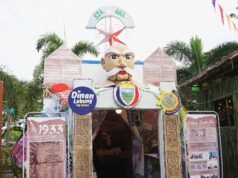SUBIC BAY FREEPORT – Famous for its historic past as a Spanish fortress and later as a well-preserved American military base, the Subic Bay Freeport is now home for the first school for sustainable tourism in the Asia-Pacific Region.
The International School of Sustainable Tourism (ISST), which is founded by former tourism Secretary Mina Gabor, now occupies the former Subic Bay Arts Center (SuBAC), a venue for cultural presentations, conferences and other programs.
Gabor said the ISST would offer various tourism courses to help boost the tourism industry in Subic and other parts of the Asia-Pacific.
In the next five days, she added, the school will start running courses like ecology lodge planning and eco-design with top quality lecturers and resource speakers from tourism establishments and related industries in the region.
Guests during the ISST opening rites included former President Fidel V. Ramos, Tourism Secretary Alberto Lim, Labor Secretary Rosalinda Baldoz, Tourism Region III Director Ronaldo Tiutico, Zambales Gov. Hermogenes Ebdane Jr., and Olongapo City first lady Anne Gordon.
They were welcomed by Gabor, Subic Bay Metropolitan Authority (SBMA) chairman Feliciano Salonga and SBMA Administrator Armand Arreza.
In his message, Ramos stressed that sustainable tourism is the key to ensuring an adequate supply of quality tourism products and services while avoiding the negative impact of the influx of visitors to the natural environment and cultural assets.
“Something tells me that with the opening of this school, the best is soon to come,” Ramos said.
He added that the ISST should serve as a platform for the government and the private sector to build the competence of communities, investors and local government units in positioning the Philippines as a hub for sustainable tourism.
“Whatever be our shared endeavors, we must ensure that these are undertaken through shared responsibilities, values, burdens and benefits towards a higher quality of life for all,” Ramos also said.
For his part, Arreza noted that the ISST now occupies the former Lowry Hall, a theater during the U.S. Navy days in Subic, which was later turned into an arts center under the SBMA.
“The seats you are sitting on are probably Korean War vintage seats, so they do have some historical value,” he said.
Arreza added that while Subic’s is a story of transformation, “the one thing that we don’t want to be transformed is the wonderful environment that we all enjoy here in Subic.”
Gabor said the ISST would offer various tourism courses to help boost the tourism industry in Subic and other parts of the Asia-Pacific.
In the next five days, she added, the school will start running courses like ecology lodge planning and eco-design with top quality lecturers and resource speakers from tourism establishments and related industries in the region.
Guests during the ISST opening rites included former President Fidel V. Ramos, Tourism Secretary Alberto Lim, Labor Secretary Rosalinda Baldoz, Tourism Region III Director Ronaldo Tiutico, Zambales Gov. Hermogenes Ebdane Jr., and Olongapo City first lady Anne Gordon.
They were welcomed by Gabor, Subic Bay Metropolitan Authority (SBMA) chairman Feliciano Salonga and SBMA Administrator Armand Arreza.
In his message, Ramos stressed that sustainable tourism is the key to ensuring an adequate supply of quality tourism products and services while avoiding the negative impact of the influx of visitors to the natural environment and cultural assets.
“Something tells me that with the opening of this school, the best is soon to come,” Ramos said.
He added that the ISST should serve as a platform for the government and the private sector to build the competence of communities, investors and local government units in positioning the Philippines as a hub for sustainable tourism.
“Whatever be our shared endeavors, we must ensure that these are undertaken through shared responsibilities, values, burdens and benefits towards a higher quality of life for all,” Ramos also said.
For his part, Arreza noted that the ISST now occupies the former Lowry Hall, a theater during the U.S. Navy days in Subic, which was later turned into an arts center under the SBMA.
“The seats you are sitting on are probably Korean War vintage seats, so they do have some historical value,” he said.
Arreza added that while Subic’s is a story of transformation, “the one thing that we don’t want to be transformed is the wonderful environment that we all enjoy here in Subic.”




